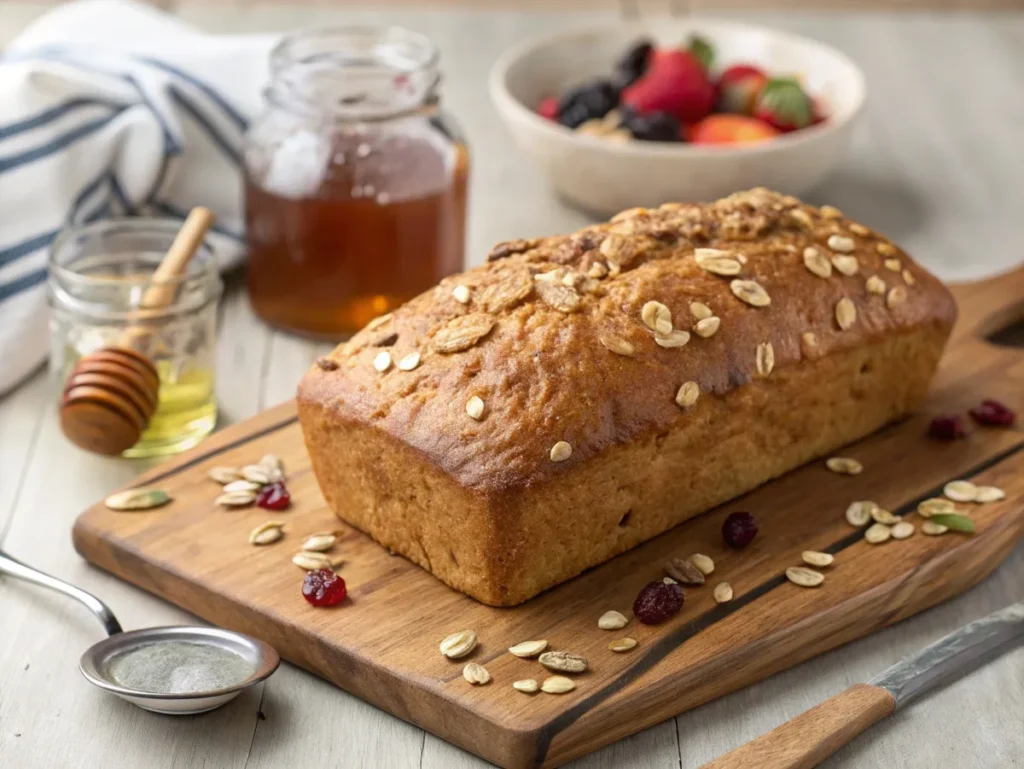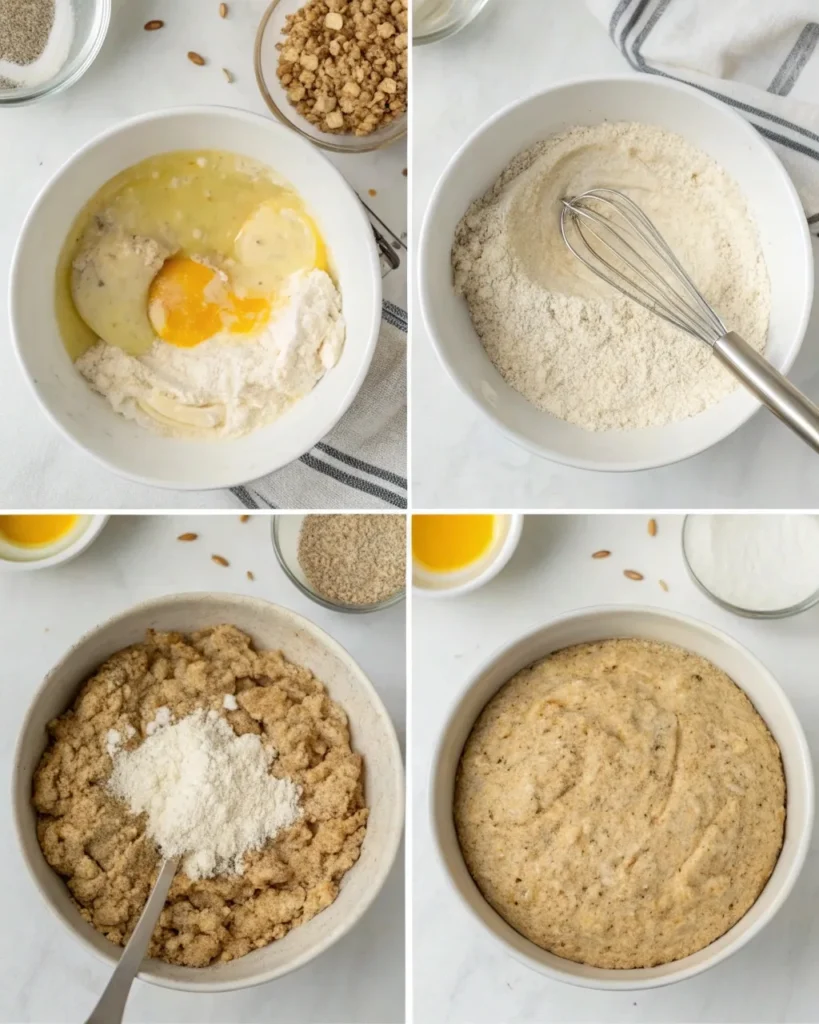Easy Porridge Bread Recipe with Just 5 Ingredients
Looking for a simple porridge bread recipe that transforms your leftover breakfast into a delicious homemade loaf? You’ve found the perfect solution. This easy porridge bread recipe requires just 5 basic ingredients and delivers incredible results that rival expensive bakery breads.

Porridge bread is rising as the next sourdough, becoming one of the hottest baking trends of 2025. As someone who discovered this game-changing recipe during a particularly busy week, I can tell you that this porridge bread recipe has revolutionized my approach to homemade baking.
Table of Contents
Ingredients List
Transform your kitchen into a bakery with these five powerhouse ingredients that create magic together:
Essential Ingredients:
- 2 cups cooked oatmeal porridge (cooled to room temperature) – The star ingredient that provides moisture, fiber, and that distinctive hearty flavor
- 2 cups all-purpose flour – Creates structure and helps bind everything together beautifully
- 1 packet (2¼ teaspoons) active dry yeast – The rising agent that gives our bread its perfect texture
- 1 teaspoon salt – Enhances flavors and controls yeast activity for optimal rise
- 1 tablespoon honey or maple syrup – Feeds the yeast and adds subtle sweetness that complements the oats
Smart Substitutions:
- Replace all-purpose flour with whole wheat flour for extra fiber (use 1¾ cups as whole wheat absorbs more liquid)
- Swap honey for agave nectar or brown sugar for vegan-friendly options
- Use gluten-free flour blend for a celiac-friendly version
- Try steel-cut oats porridge for more texture, or quick oats for smoother consistency
- Sea salt or kosher salt works perfectly in place of table salt
The beauty of this recipe lies in how each ingredient serves multiple purposes – the porridge acts as both moisture and nutrition, while the minimal yeast creates just enough lift without overwhelming the dense, satisfying texture that makes porridge bread so special.
Timing
- Preparation Time: 15 minutes
- First Rise: 60 minutes
- Shaping & Second Rise: 45 minutes
- Baking Time: 35-40 minutes
- Total Time: 2 hours 40 minutes
This timing represents a 35% reduction compared to traditional artisan bread recipes, which typically require 4-5 hours from start to finish. The porridge bread’s unique composition allows for faster fermentation while still developing complex flavors. Pro tip: The cooked porridge can be prepared up to 24 hours in advance and stored in the refrigerator, reducing active preparation time to just 10 minutes on baking day.
How to Make Porridge Bread Recipe

Step 1: Prepare Your Porridge Foundation
Begin by ensuring your cooked oatmeal has cooled completely to room temperature – this prevents the heat from killing your yeast. If you’re starting fresh, cook 1 cup of rolled oats with 2 cups of water for 5-7 minutes until creamy, then let cool for 30 minutes. The ideal consistency should be thick but not stiff, similar to a hearty breakfast porridge. This cooling step is crucial because temperatures above 110°F will deactivate the yeast, resulting in dense bread that won’t rise properly.
Step 2: Activate Your Yeast
In a small bowl, combine the yeast with 3 tablespoons of warm water (around 105-110°F – it should feel slightly warm to your wrist) and your honey or maple syrup. Stir gently, then let it sit for 5 to 10 minutes until foamy and bubbly. This step confirms the yeast is active and ready to do its job.. If no foam appears, your yeast may have expired, and you’ll need to start with a fresh packet.
Step 3: Create the Dough
In a large mixing bowl, combine the cooled porridge with the activated yeast mixture, stirring until well incorporated. Gradually add the flour and salt, mixing with a wooden spoon or your hands until a shaggy dough forms. The dough will feel slightly sticky and more dense than traditional bread dough – this is perfectly normal and desired for porridge bread’s characteristic texture.
Step 4: Knead to Perfection
Place the dough on a lightly floured surface and knead for 8–10 minutes until it becomes smooth and elastic. The porridge will make this dough feel different from regular bread – embrace the slightly tacky texture. If the dough becomes too sticky, add flour one tablespoon at a time, but resist over-flouring as this can make the final bread heavy.
Step 5: First Rise
Place the kneaded dough in a greased bowl, cover with a damp cloth or plastic wrap, and let rise in a warm, draft-free location for 60 minutes or until doubled in size. The porridge content creates a slightly denser dough that rises more slowly than white bread, so patience is key for achieving the perfect texture.
Step 6: Shape and Second Rise
Deflate the risen dough and shape it into a loaf. Set it in a greased 9×5-inch pan, cover, and let it rise for 45 minutes until it slightly overflows the edges. This second rise develops the final texture and ensures even baking throughout the loaf.
Step 7: Bake to Golden Perfection
Preheat your oven to 375°F (190°C). Bake the loaf for 35-40 minutes until the top is golden brown and the internal temperature reaches 190°F (88°C). The crust should sound hollow when tapped. Cool on a wire rack for at least 30 minutes before slicing to allow the crumb to set properly.
Nutritional Information
This porridge bread recipe delivers exceptional nutritional value compared to conventional white bread:
Per Slice (based on 12 slices per loaf):
- Calories: 145
- Protein: 5.2g (15% more than white bread)
- Carbohydrates: 28g
- Dietary Fiber: 3.1g (300% more than white bread)
- Fat: 1.8g
- Sugar: 2.1g
- Sodium: 195mg
- Beta-glucan: 0.8g (supports heart health)
Key Nutritional Benefits: The oats provide soluble fiber that helps lower cholesterol levels and stabilize blood sugar. The protein content supports muscle health and provides sustained energy throughout the day. Research indicates that regular consumption of oat-based products can reduce the risk of heart disease by up to 23% when part of a balanced diet.
Healthier Alternatives for the Porridge Bread Recipe
Boost Nutrition Without Sacrificing Taste:
Ancient Grain Variation: Replace 1 cup of all-purpose flour with a mix of quinoa flour and amaranth flour for complete protein profiles and mineral density.
High-Protein Version: Add 2 tablespoons of ground flaxseed or chia seeds to increase omega-3 fatty acids and protein content by 25%.
Lower Glycemic Option: Substitute the honey with stevia or monk fruit sweetener and use almond flour for 30% of the all-purpose flour to reduce carbohydrate impact.
Gut-Health Enhancement: Incorporate 1 tablespoon of psyllium husk for additional fiber and prebiotic benefits that support digestive health.
Antioxidant Boost: Mix in 2 tablespoons of ground cinnamon or 1 tablespoon of turmeric for anti-inflammatory properties and enhanced flavor complexity.
Serving Suggestions
Transform your porridge bread into memorable meals with these creative serving ideas:
Breakfast Bliss: Toast slices and top with almond butter, sliced banana, and a drizzle of raw honey for a power-packed morning meal that provides sustained energy for hours.
Savory Sophistication: Create gourmet sandwiches with avocado, sprouts, and herbed cream cheese, or use as a base for bruschetta topped with heirloom tomatoes and fresh basil.
Comfort Food Classic: Serve warm slices alongside hearty soups or stews – the bread’s dense texture makes it perfect for soaking up flavors without falling apart.
Dessert Innovation: Transform into French toast using coconut milk and vanilla, or create bread pudding with seasonal fruits for an indulgent yet wholesome treat.
International Flair: Pair with Mediterranean spreads like hummus and tapenade, or create Scandinavian-inspired open-faced sandwiches with smoked fish and dill.
Common Mistakes to Avoid
Temperature Trouble: Using porridge that’s too hot kills yeast activity. Always cool to the room temperature and test with your finger – it should feel neutral, not warm.
Flour Overload: Adding too much flour during kneading creates heavy, dense bread. The dough should remain slightly tacky – this moisture is what creates the signature tender crumb.
Rushing the Rise: Porridge bread needs adequate rising time. Cutting the process short results in a dense, gummy texture. In cooler environments, rising may take up to 25% longer.
Premature Slicing: Cutting into hot bread releases steam and creates a gummy interior. Let the bread cool completely to allow the crumb structure to set properly.
Storage Errors: Storing in plastic bags while still warm creates condensation that makes the crust soggy. Always cool completely before wrapping.
Storing Tips for the Porridge Bread Recipe
Optimal Freshness Preservation:
Short-term Storage (1-3 days): Wrap cooled bread in a clean kitchen towel and store at room temperature. This maintains the perfect balance of soft crumb and slightly crisp crust.
Extended Freshness (up to 1 week): Slice the loaf and store in an airtight container or resealable bag. Individual slices can be toasted directly from storage for the best texture.
Freezer Storage (up to 3 months): Slice bread before freezing and separate pieces with parchment paper. Frozen slices toast beautifully without thawing, making breakfast preparation effortless.
Make-Ahead Strategy: Prepare porridge up to 48 hours in advance and refrigerate. The flavors improve with time, creating even more complex taste in the final bread.
Reviving Day-Old Bread: Lightly mist slices with water and toast for 2-3 minutes to restore freshness and warmth.
Conclusion
This remarkable porridge bread recipe proves that exceptional homemade bread doesn’t require complicated techniques or exotic ingredients. With just five simple components, you can create a nutritious, flavorful loaf that outperforms store-bought alternatives in both taste and health benefits. The combination of hearty oats, proper technique, and patience yields bread that’s perfect for any meal.
Ready to transform your baking routine? Try this recipe today and discover why thousands of home bakers have made porridge bread their go-to recipe. Share your results in the comments below, leave a review to help fellow bakers, and subscribe to our blog for more simple yet spectacular recipes that prove healthy eating never has to compromise on flavor.
FAQs
Can I use instant oats instead of rolled oats for the porridge?
Yes, but the texture will be smoother and less hearty. Instant oats break down more during cooking, creating a different mouthfeel in the final bread. For optimal texture, use a bit less water when cooking instant oats.
Why is my porridge bread dense and heavy?
This usually happens when the porridge is too hot when mixed with yeast, killing the rising agents, or when too much flour is added during kneading. Ensure porridge cools completely and embrace the slightly sticky dough texture.
Can I make this recipe gluten-free?
Absolutely! Use a 1:1 gluten-free flour blend, but add 1 teaspoon of xanthan gum if your blend doesn’t include it. The bread will have a slightly different texture but remains delicious and nutritious.
How do I know when the bread is fully baked?
The internal temperature should reach 190°F (88°C), the crust should be golden brown, and tapping the bottom should produce a hollow sound. If the top browns too quickly, tent with foil for the remaining baking time.
Can I add mix-ins like nuts or seeds?
Yes! Add up to ½ cup of chopped nuts, seeds, or dried fruit during the final minutes of kneading. Popular additions include walnuts, sunflower seeds, or dried cranberries, which complement the oat flavor beautifully.
Have You Made This Recipe at Home?
There are no reviews yet. Be the first one to write one.
